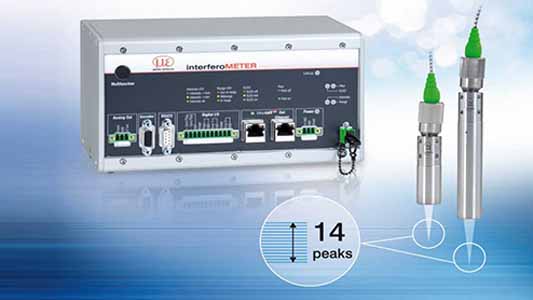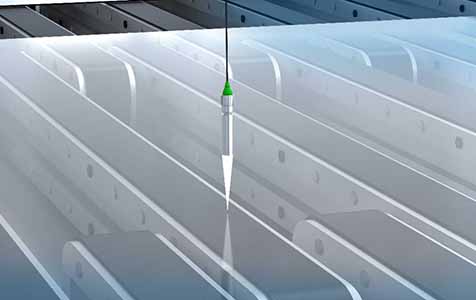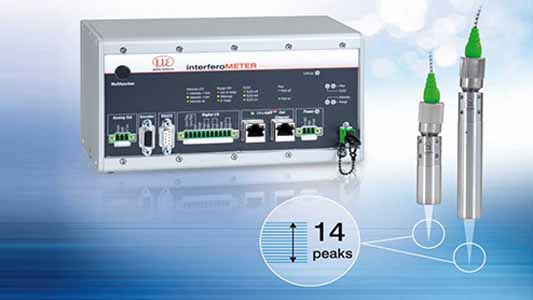Measuring the thickness of very thin layers is a major challenge in many industrial applications. For optically transparent layers, such as thin glass or films, interferometry is a well-suited method that can work without making contact and with accuracies down to the nanometer range. Micro-Epsilon is now introducing new systems that simultaneously detect multiple layers and still measure the distance.
The measurement method of interferometry is based on the wave nature of light. If two waves are superimposed, constructive interference can occur when wave crest meets wave crest or wave trough meets wave trough. Destructive interference can occur when wave crest meets wave trough. This phenomenon is also the reason why, for example, an oil film on a puddle shimmers in rainbow colors. Here, the light reflected from the oil surface overlaps with the light reflected from the boundary layer between oil and water. Depending on the thickness of the oil layer, constructive or destructive interference occurs at different wavelengths – colors – of light. The accuracy is in the nanometer or even sub-nanometer range.
Measure multiple layers simultaneously

The white light interferometers from Micro-Epsilon operate according to the method described above. The SLDs used have a spectrum with a focus in the near infrared range at around 840 nm. White light interferometers are the most precise optical measuring systems currently available from Micro-Epsilon. They offer very high accuracy and resolution down to the sub-nanometer range. The system consists of a compact sensor and a controller protected in a rugged industrial housing. The active temperature control included in the controller ensures high measurement stability. The devices are available in two different versions that can be used to measure either distances to a reflective surface or a coating thickness. In the first version, the beam is split in the sensor and passes internally through a reference path. This partial beam is then superimposed with the beam reflected at the target. The second version of the instruments, which can measure coating thicknesses, eliminates the internal reference by superimposing the beams reflected at the front and back of the coating. A major advantage of thickness measurement is that the measurement is independent of the distance between the sensor and the measured object.
If the thickness of several layers is measured simultaneously, a large number of peaks in the spectrum must be evaluated.
Micro-Epsilon has introduced new versions of these measuring devices, which have already proven themselves in numerous applications over a number of years and feature decisive improvements. These can now also measure the thickness and distances of several layers simultaneously.
Applications in numerous industries
In all applications where distances and thicknesses must be measured with high precision and, if necessary, simultaneously, the white light interferometers from Micro-Epsilon are the ideal choice. The devices each consist of a compact sensor – with an internal reference in the case of distance measurement – and a controller. Users can easily access the controller’s integrated web server via a standard browser to make settings, for example. The integrated interfaces, for example Ethernet, EtherCAT or digital inputs and outputs, simplify integration of the measuring devices into production environments.

In all applications where distances and thicknesses must be measured with high precision and, if necessary, simultaneously, the white light interferometers from Micro-Epsilon are the ideal choice, as shown here in the measurement of precision glass.
Possible areas of use are found in applications with glass or films. A typical example is the semiconductor industry, where the exact distance to the wafer must be measured. During exposure, the distance between the wafer and the mask can also be determined here and, at the same time, the thickness of the coating on the wafer.
Coated glass in the glass industry is another example where these measuring instruments are used. Both the glass thickness and the thickness of the coating can be inspected. Such glass is used as display glass, for example. In film production with blow molding equipment, white light interferometry can be used to verify the correct film thickness when the blown films are collapsed. In all applications, the devices can be integrated into inline inspection systems for quality assurance. They can be used in industrial environments, as well as in clean rooms or in a vacuum and perform precise measurements down to the nanometer or sub-nanometer range.
Micro-Epsilon India Private Limited
Office No. 101 A | Delta 1 Giga Space IT Park
Viman Nagar – 411014, Pune | Maharashtra
Tel.: +91 20 4913 1030 | Fax: +91 20 4913 1001
info@micro-epsilon.in | www.micro-epsilon.in











